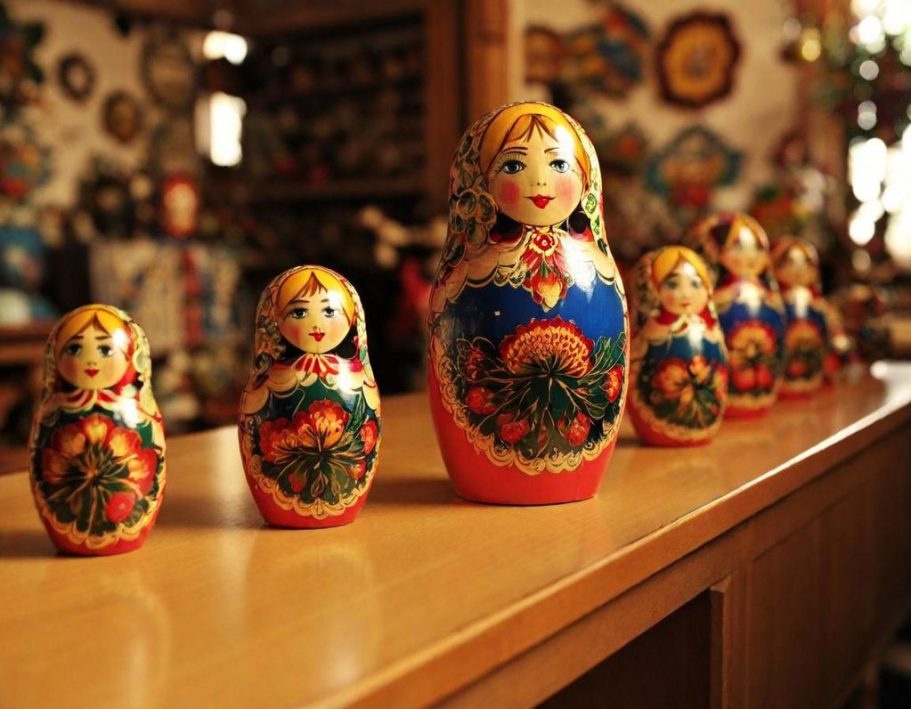Yulsee Digitype's World News Report
My columns for Sans Cerebrum News delve into the complexities of global affairs, going beyond the headlines to examine the underlying cultural currents and human stories that shape our world. From dissecting geopolitical shifts and their impact on everyday lives, to exploring the societal implications of emerging technologies, and even examining the subtle cultural nuances that drive international relations, I strive to provide comprehensive and insightful analysis. You can expect a rigorous pursuit of truth, presented with a clarity that cuts through rhetoric, always seeking to understand the deeper "why" behind the "what" in our ever-evolving global landscape.

Russian Nesting Dolls Resting on a Table #2 - By Getty AI
The Matryoshka President: Unpacking the Layers of a Russian Asset
By Yulsee Digitype, World News Correspondent
Here at Sans Cerebrum News, we pride ourselves on a rigorous pursuit of truth, even when that truth is as layered and unsettling as a Russian nesting doll. Today, we confront claims, deemed highly credible by various sources, that the former U.S. President, Donald Trump, is, in essence, a "Matryoshka asset"—a figure seemingly American on the surface, but with deeper, concealed layers of Russian influence. This isn't about fleeting speculation; it's about examining the cultural significance of the Matryoshka itself—symbolizing family unity, fertility, abundance, and the search for truth hidden within many layers—and asking if this symbol, ironically, now applies to the highest echelons of global power.
The implications of such a revelation, should it be definitively proven, are not merely political; they ripple outwards, touching every corner of our interconnected world, often in ways one might not immediately fathom. Consider, for a moment, the Canadian moose population. While seemingly disconnected from the machinations of global politics, a fundamental shift in U.S. foreign policy due to external influence could lead to altered trade agreements, potentially impacting resource allocation and environmental regulations across North America. Changes in economic priorities or even shifts in alliances could lead to increased industrial development in Canadian wilderness areas, fragmenting habitats, altering migration patterns, and introducing new stressors to an already delicate ecosystem. Moose populations, already facing challenges from habitat alteration and disease, could find themselves inadvertently caught in the crosscurrents of a geopolitical revelation.
And what of the dolphins? These highly intelligent, socially complex marine mammals, whose own societal structures sometimes echo human "politics," are keenly attuned to changes in their marine environment. An international scandal of this magnitude could lead to unpredictable shifts in global shipping routes, increased naval activity for security purposes, or even a re-evaluation of marine conservation efforts as nations prioritize immediate geopolitical concerns. Noise pollution, habitat degradation, and altered prey availability could all become more prevalent, disrupting their intricate communication and foraging behaviors. The very trust in international cooperation for marine protection, which is vital for these sentient beings, could erode. When the dust settles on this extraordinary claim, and the deepest doll within the Matryoshka is revealed, the world, from the majestic moose of the Canadian wilds to the intelligent pods of the ocean, will never quite be the same. The truth, like those nested dolls, demands to be fully opened, no matter how many layers it contains or how unsettling the final revelation.
When investigating the profound claim of a former U.S. President being a Russian "Matryoshka asset," one must meticulously sift through the layers of information, separating substantiated evidence from mere speculation. At Sans Cerebrum News, our commitment to truth demands nothing less.
One of the most prominent sources that first brought these kinds of allegations to public attention was the Steele Dossier, a series of reports compiled by former British intelligence officer Christopher Steele in 2016. While highly controversial and containing unverified allegations, it alleged a "well-developed conspiracy of cooperation" between the Trump campaign and the Russian government. Though many of its more salacious claims remain unproven and have been called into question by subsequent reports, the dossier's very existence, and the fact that intelligence agencies took it seriously enough to brief the President and President-elect, signaled a concern at the highest levels. Former CIA officer John Sipher, in an interview on PBS, acknowledged the unverified nature of specific allegations within the dossier but noted that some aspects aligned with known Russian intelligence methods of cultivating assets through "kompromat" or compromising material.
More recently, the allegations have been reignited by figures with purported intelligence backgrounds. Alnur Mussayev, a former Soviet and Kazakh security official, recently claimed in February 2025 via Facebook that Donald Trump was recruited by the KGB in 1987 and given the codename "Krasnov." While Mussayev's claims, specifically his role within the KGB's structure, have been debated and do not align with official records of his work history, his assertions have certainly fueled the fire of public discussion. These claims suggest that Trump's 1987 visit to Moscow for real estate dealings was, in fact, a covert operation. The cultural reverberations of a powerful figure having a secret, decades-long codename – a classic spy trope – are immense, weaving a narrative that captures the imagination and deepens existing anxieties about foreign influence.
Further insights come from journalists and former intelligence personnel who have explored the concept of "cultivation" rather than outright recruitment as an agent. The 2021 book "American Kompromat" by journalist Craig Unger features interviews with former KGB spy Yuri Shvets, who claims Trump was "cultivated as a Russian asset over 40 years." Shvets, a figure whose credibility has been analyzed, suggests that Russia saw in Trump a potential "useful idiot"—someone whose personal interests and vulnerabilities could be subtly leveraged, even if he wasn't a witting spy. This aligns with the Matryoshka concept; a seemingly independent outer shell, but with inner layers manipulated by external forces. The key distinction here is between a full-blown "agent" who knowingly provides intelligence, and an "asset" who might be unwittingly used or whose actions inadvertently benefit a foreign power due to shared interests or vulnerabilities.
Then there is the extensive Mueller Report itself. While the Special Counsel's investigation did not establish a criminal conspiracy between the Trump campaign and the Russian government, it detailed "sweeping and systemic" Russian interference in the 2016 election. Crucially, it documented numerous contacts between Trump campaign officials and individuals tied to the Russian government. Key figures like Paul Manafort, Michael Flynn, George Papadopoulos, and Jared Kushner had documented interactions, and several of them later admitted to lying to investigators about these contacts. Michael Flynn, for instance, received payment from Russia Today (RT), a Kremlin-supported channel, and failed to disclose foreign income. The report also detailed efforts by President Trump to impede the investigation, which prompted over 1,000 former federal prosecutors to conclude that if any other American engaged in similar efforts, they would likely be indicted for obstruction of justice. While not directly confirming the "Matryoshka asset" claim, these documented instances of deception, unusual contacts, and a consistent public stance sympathetic to Russia, when viewed through the lens of Russian intelligence tradecraft, certainly add layers to the narrative.
The cultural impact of these credible, albeit sometimes debated, sources is profound. It suggests a vulnerability at the very heart of democratic institutions, a potential erosion of sovereignty from within. For the Canadian moose, this persistent shadow of foreign influence could manifest in an unstable global economy, leading to unpredictable shifts in resource demand and land use policies in their pristine habitats. Consider the potential for increased demand for timber or mineral extraction driven by a U.S. administration prioritizing short-term economic gains influenced by external agendas. This could mean more clear-cutting, more infrastructure, and less vital wilderness for these majestic creatures.
And the dolphins, those intelligent denizens of the deep, whose future depends so much on stable international cooperation for marine conservation? If the global political landscape becomes further fractured by suspicions of deeply embedded foreign assets, the very framework of multilateral agreements that protect our oceans could weaken. Scientific research, vital for understanding and protecting dolphin populations, often relies on international funding and collaboration. A breakdown in trust between nations, fueled by revelations of covert influence, could see such vital efforts sidelined, funding diverted, or even data sharing become compromised. The ripples from these Matryoshka revelations, it seems, will continue to expand, touching even the most unexpected corners of our interconnected world, leaving an indelible mark on everything from international relations to the very ecosystems that sustain life on this planet. The truth, like the deepest doll, is often the most unsettling.
